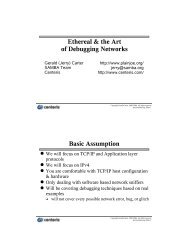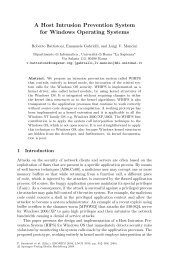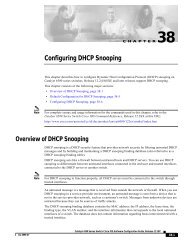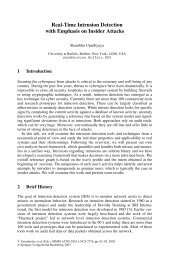Advanced Windows 2000 Rootkit Detection (Execution Path Analysis)
Advanced Windows 2000 Rootkit Detection (Execution Path Analysis)
Advanced Windows 2000 Rootkit Detection (Execution Path Analysis)
Create successful ePaper yourself
Turn your PDF publications into a flip-book with our unique Google optimized e-Paper software.
inc counter;<br />
iret;<br />
iret;<br />
IDT<br />
...<br />
0h<br />
1h (#DB)<br />
2h<br />
FFh<br />
Figure 8. Simple attack against EPA.<br />
To defend against such attack, we can make use of Intel debug registers. We can use DR0<br />
and DR1 registers to protect whole IDT 1 entry (which is 8 bytes long) against writing<br />
access. In addition we would like to protect this entry against reading, to not allow<br />
hooking debug handler by just inserting jmp instructions somewhere at the beginning of<br />
the debug handler. In other words, we do not want the rootkit to be able to find the<br />
address of debug handler.<br />
However we can not simply protect IDT #1 from reading (by setting appropriate flags in<br />
DR7) because the system will bluescreen, as experience has showed. But there is a simple<br />
solution, which involves adding an extra layer. The solution is depicted on figure 9.<br />
read & write<br />
protection<br />
handler1:<br />
jmp handler2<br />
IDT<br />
0h<br />
write<br />
protection<br />
1h (#DB)<br />
handler2:<br />
inc counter<br />
iret<br />
...<br />
2h<br />
FFh<br />
Figure 9. Hardware protection against #DB hooking.<br />
10









